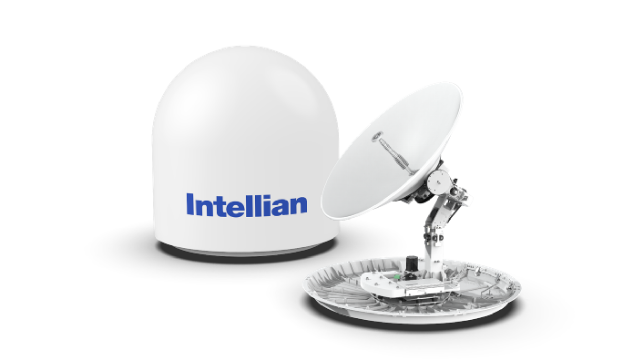Tomorrow’s Developments Today
Eric Sung, CEO of Intellian Technologies, asks: Is the maritime industry ready for a fully connected future?

Geostationary (GEO) satellites have provided sterling service for many years in the field of broadband data transmission. The most widely-known property of high-orbiting geostationary satellites is that when viewed from the ground, they appear to occupy a fixed point in the sky – but nothing ever remains fixed, not least the principles and processes of satellite technology.
Given the ever-increasing demand for rapid, seamless yet cost-effective broadband coverage, the coming years are set to witness a massive expansion in the deployment of new Non-Geostationary-Satellite Orbit (NGSO) constellations, coupled with substantial reinvestment in the GEO market to raise the throughput and capacity of these satellites – and it’s vitally important that shipowners are prepared for what looks set to become a key technological evolution. This expansion in the GEO and NGSO markets indicates a wider investment across the satellite communications industry which is driving innovation not just in terms of the technology itself, but also in terms of creating new, bespoke business models.
For the maritime industry, a central advantage of NGSO constellations is the fact that with a shorter round-trip data transfer distance, the compact, low-mass, economical Low Earth Orbit (LEO) and Medium Earth Orbit (MEO) smallsats and nanosats offer lower latency than earlier-generation satellites, while also expanding the footprint of where ships can reliably connect. Similarly, an increase in service flexibility matched with a significant boost in throughput will have the knock-on effect of driving down costs per megabit and allowing for much faster internet access.
As a satellite antenna manufacturer, our focus has been trained on anticipating and facilitating this step-change. However, while several test LEO satellites from various network owners are already in the sky, full services for maritime users are still likely to be some years away. This begs a pertinent question for any shipowners or managers looking to upgrade onboard communications in the pursuit of digitalization-enabled efficiencies: should I wait while the burgeoning NGSO sector starts to take shape, or should I move now?
In truth, there can only be one answer. It’s already self-evident that digitalization is overhauling the maritime industry at the proverbial rate of knots, and progress has a sobering habit of penalizing those who are slow off the mark. Hesitating to acknowledge the imminent next phase of high-performance satellite broadband communication is an oversight and a false economy – particularly in view of the fact that future-proof technology already exists which can bridge the gap as a matter of course. Equipped with future-proof terminals, shipping companies can address the increased demand for sophisticated onboard networks which will rise proportionately with the growing use of connectivity services in all aspects of fleet operations.
So, quite simply, the key is to invest in a multi-orbit maritime VSAT antenna system which has the flexibility to not only operate with GEO satellites, but which is also configured to be readily compatible with forthcoming MEO and LEO satellites, offering the ability to auto-switch across C-, Ku- and Ka-band frequencies.
For our part, we’re pleased to have set this precedent and to be promoting a common-sense mindset which builds next-generation preparedness into every product. By future-proofing the wideband Ka-ready radome and reflector in our new maritime Global Xpress terminal, for example, the thinking is that clients can be spared the time and expense of having to replace these structures when the service comes online.
Similarly, it is surely prudent to offer block upconverter (BUC) options enabling users to upgrade to even higher bandwidth without having to purchase and fit any extra components. Now more than ever, it is incumbent upon satellite antenna manufacturers to work in tandem with service providers to directly address the constantly accumulating high-bandwidth requirements of maritime users such as crews on board cruise ships, offshore energy vessels and seismic survey craft whose operational and recreational functions rely upon fast, disruption-free global connectivity.
The principle of pursuing the high-performance, low-latency and cost-effective solutions made possible by LEO and MEO ecosystems also applies to satellite communications in the broader sphere, of course. User terminals that specifically expedite remote enterprise networks are already being manufactured, particularly benefiting businesses located in hard-to-reach areas and users compromised by economical as well as geographical factors – hospitals, schools, community centers and farms.
It hardly needs pointing out that such terminals’ suitability for all-areas, data-intensive coverage is indicative of a commitment to the affordable, seamless, always-on characteristics of NGSO-based and next-generation GEO systems which seem destined to become the norm. The time can’t be far away when users will expect nothing less, and the sooner the maritime industry takes this consideration on board, the better all round for shipowners, ship managers, fleet operators, crews and passengers alike. The advantages are inarguable: higher throughput, lower latency, lower capital and operational expenditure, plus a far wider choice of connectivity services.
Reflecting the developmental trajectory in the bigger picture, the future of maritime broadband will inevitably revolve around greater service levels and vastly improved efficiency, matched with a healthy return on investment of course. Innovation, flexibility and affordability need to be intermingled primary objectives for any satellite antenna manufacturer taking the long view, and the capacity to predict and drive tech trends can only translate into user benefits right across the board. In both the literal and metaphorical senses, the best-prepared satellite technology companies will watch the skies so that you don’t have to.
Eric Sung is CEO of Intellian Technologies.
The opinions expressed herein are the author's and not necessarily those of The Maritime Executive.
